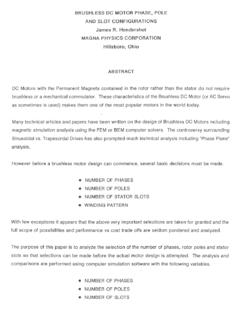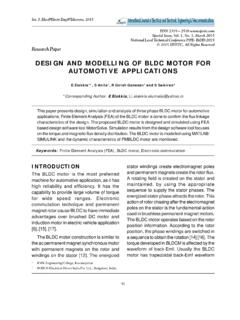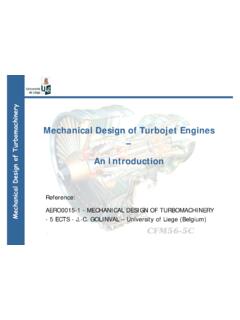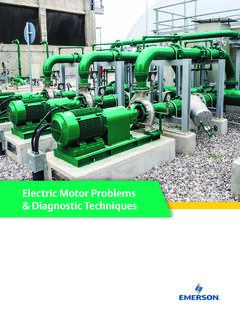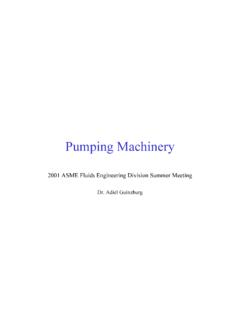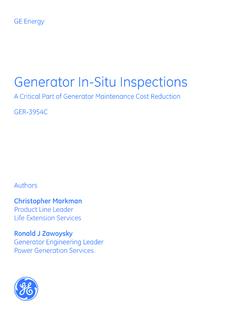Transcription of Doubly fed induction generator uising back-to-back PWM ...
1 Doubly fed induction generator uising back-to-back PWM converters and its application to variable- speed wind-energy generation R. Pena G. M. As her Indexing terms: Doubly fed induction motor, P WM converters, Vector control, Wind energy Abstract: The paper describes the engineering and design of a Doubly fed induction generator (DFIG), using back-to-back PWM voltage-source converters in the rotor circuit. A vector-control scheme for the supply-side PWM converter results in independent control of active and reactive power drawn from the supply, while ensuring sinusoidal supply currents. Vector control of the rotor-connected converter provides for wide speed-range operation; the vector scheme is embedded in control loops which enable optimal speed tracking for maximum energy capture from the wind.
2 An experimental rig, which represents a kW variable speed wind- energy generation system is described, and experimental results are given that illustrate the excellent performance characteristics of the system. The paper considers a grid-connected system; a further paper will describe a stand-alone system. List of symbols V, = RMS stator voltage V, = RMS rotor voltage ml, m2 = stator and rotor converter modulation depths E = DC link voltage s = slip n = stator ~ rotor turns ratio L, R = inductance and resistance of supply side induc- tors v,, vb, v, = 3-phase supply voltages vd, vq, v,, vp = 2-axis supply voltages val, vbl, vbl = 3-phase stator converter terminal volt- ages vdl, vql = 2-axis stator converter terminal voltages i,, ib, i,= 3-phase stator converter input currents id, i, = 2-axis stator converter input currents 0 IEE, 1996 ZEE Proceedings online no.
3 19960288 Paper received 27th July 1995 The authors are with the DeDartment of Electrical & Electronic Enpineer- ing, The University of NotGnghm, University Park, Nottinghm- NG7 2RD, UK a,, a,, aAl, = supply, rotor, slip angular frequency P, Q = active and reactive power e,, 8, = supply voltage, stator flux vector position io,, io, = stator and rotor converter DC-link currents C = DC-lirtk capacitance F(s), F(z) = plant-transfer functions G(z) = controller-transfer function 5 = damping factor h = flux linkage L,, L,, L,, Lo = machine inductances per phase R,, R, = machine resistances per phase 0 = leakage factor i,, = stator magnetising current P = pole pairs K,, K,, K,, K, = controller gains a,, a,, a,, a,, = controller parameters P,, P,,, P,,, = mechanical, optimum, maximum power Cp, h, p, r = turbine power coefficient, tip speed ratio, pitch angle, radius v = wind velocity B, J = friction, inertia T,, T, = electromagnetic, mechanical torque Tau, = auxiliary torque variable KoI, Ko2 = Kalman-filter gains Suffices, Superscripts d, q = d-q axis s, r = stator , rotor A = estimated value - = predicted value * = demanded (reference)
4 Value 1 Introduction The Doubly fed induction machine using an AC-AC converter iin the rotor circuit (Scherbius drive) has long been a standard drive option for high-power applica- tions involving a limited speed range. The power con- verter need only be rated to handle the rotor power. Vector-control techniques for the independent control of torque and rotor excitation current are well known [l], whilst Jones and Jones [2], for example, have shown that a vector-control strategy can be used for decou- pled control of active and reactive power drawn from the supply. Wind-energy generation is regarded as a 231 IEE Power Appl., Vol. 143, No 3, May 1996 natural application for the Scherbius DFIG system, since the speed range (from cut-in to rated wind veloc- ity) may be considered restricted.
5 Most Scherbius DFIG systems reported employ either a current-fed (naturally commutated) DC-Link converter [3-5] or cycloconverter [6-91 in the rotor circuit. Smith et al. [3] describe the rated speed settings, gearbox ratios, and machine and converter ratings for variable-speed wind generation using the DFIG. Cardici and Ermis [4], and Uctug et al. [5], have presented strategies aimed at maximising the total electrical power output from the DFIG. The use of a current-fed DC-link converter has a number of disadvantages: the DC-link choke is expensive, and an extra commutation circuit is required for operation at synchronous speed (which lies within the operational speed range), and this has resulted in poor performance at low slip speeds [4]. In addition, such a converter draws rectangular current waveforms from the supply.]
6 The problem at synchronous speed may be overcome by use of a cycloconverter, and vec- tor-controlled Scherbius schemes with 6-pulse cyclo- converters have been described by Leonhard [ 11 and Walczyna [6]. Yamamoto and Motoyoshi [7] have pre- sented a detailed analysis of the current harmonics drawn from the supply, which is still a problem in this type of drive. Machmoum et al. [8] have presented an implementation with a simpler 3-pulse cycloconverter, whilst Holmes and Elsonbaty [9] describe a similar con- verter to excite a divided-winding Doubly -fed machine, which improves the speed range to 50% slip at the expense of increased machine complexity. Both of these schemes have the disadvantage of requiring a trans- former to form the neutral; in addition, naturally commutated DC-link and cycloconverter schemes may, in many cases, require a transformer for voltage matching.]
7 The disadvantages of the naturally commutated DC- link and cycloconverter schemes can be overcome by the use of two PWM voltage-fed current-regulated inverters connected back-to-back in the rotor circuit. The characteristics of such a Scherbius scheme, in DC drive r---i Fig. 1 which both converters are vector controlled, are as follows: operation below, above and through synchronous speed with the speed range restricted only by the rotor- voltage ratings of the DFIG operation at synchronous speed, with DC currents injected into the rotor with the inverter working in chopping mode low distortion stator , rotor and supply currents independent control of the generator torque and rotor excitation Control of the displacement factor between the volt- age and the current in the supply converter, and hence control over the system power factor.
8 Surprisingly, given the obvious advantages, Scherbius schemes using this arrangement have received little attention in the literature. Such a scheme was reported by Bogalecka [lo] and Tang and Xu [l I], using simula- tion studies, but the authors have not verified the per- formance of the system experimentally. In this paper, a full engineering study of an experimental back-to-back PWM vector Scherbius scheme is presented, with experimental results verifying the performance flexibil- ity of the system. Since the research was initiated as part of a research program into new generator schemes for wind energy, the paper describes an implementation directed at wind generation, with the restriction that the system is connected to a grid. A stand-alone imple- mentation is beyond the scope of the paper, and will be described in a future publication.
9 2 Experimental system A schematic diagram of the overall system is shown in Fig. 1. The DFIG used was a , 415V, 50Hz 6- pole machine, whose parameters are given in the Appendix. Two voltage-fed PWM converters are inserted in the rotor circuit, with the supply-side PWM converter connected to the statorisupply via three sin- gle-phase chokes. The user interface Schematic of experimental system voltage-transfer characteristics 3-phose varioc supply IEE Power Appl, Vu1 143, No. 3, May 1996 232 of the system, including the .?-phase back-to-back PWM converters, are given approximately by (1) where n is the stator -rotor turns ratio of the DFIG ( for the machine used), s is the slip and q, in2 are the PWM modulation depths of the stator -side and rotor- side converters respectively.
10 Eqn. 1 determines the speed range of the generator . The stator -side converter modulation depth is nominally (as discussed below), and the maximum modulation depth for the rotor--side converter is approximately This gives a theoretically possible speed range of 0 to 2000rpm for the 6-pole machine. In fact a lower speed range is used in practice since a full speed range from zero to twice- rated requires the PWM converters to be of equal rat- ing to the machine, and this undermines the advantage of the Scherbius scheme. For wind generation, a restricted speed range is acceptable on account of a minimum wind velocity (the cut-in speed), below which very little energy is extractable. The generator speed corresponding to rated wind velocity can be set at any point by thc choice of gearbox ratio.










